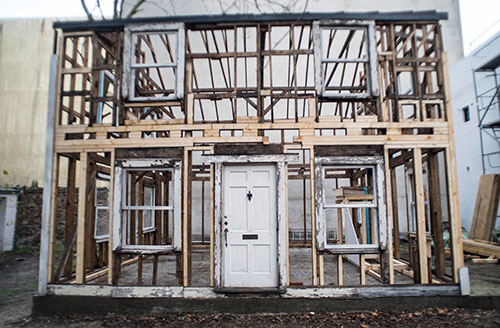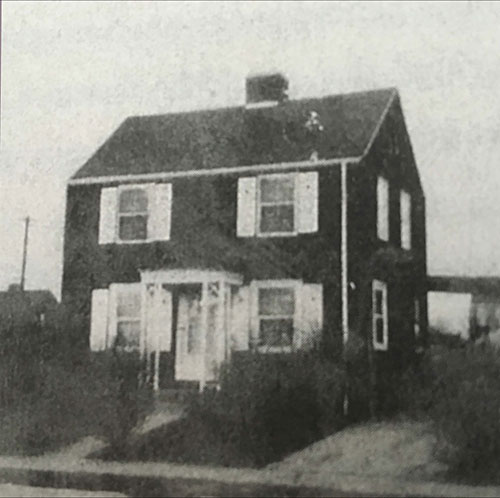PROVIDENCE, R.I. [Brown University] —After months of planning, final preparations are underway for the former family house of civil rights pioneer and American icon Rosa Parks to arrive at Brown University. The house is making its way to Providence in a trans-Atlantic voyage from its most recent home in Germany for a three-month exhibition expected to open to the public on April 3.
[Editor’s Note — March 8, 2018: Due to circumstances beyond Brown University’s control, the Rosa Parks exhibition described in this story has been cancelled. The University has issued a statement explaining that a separate exhibit on the Civil Rights Movement will proceed.]
Brown University’s Center for the Study of Slavery and Justice (CSSJ) has organized the repatriation of the house to the U.S. and is partnering with WaterFire Providence to make it accessible to the public. Since 2016, the house has been on public display in the Berlin backyard of American artist Ryan Mendoza.

Fabia Mendoza
After weeks of reassembly and preparation, the public will be invited to engage with the legacy of Parks’ activism and the Civil Rights Movement in an exhibit space Brown is preparing at a former factory WaterFire has renovated in Providence.
“The intensity of our current national discourse around issues of race demonstrates the urgency of addressing the issues Rosa Parks confronted,” said Brown President Christina Paxson. “The opportunity to host the Rosa Parks house will build on a tradition of dialogue at Brown on race, racism and the legacies of slavery.”
Many people know of Rosa Parks through her iconic act of defiance that sparked the Montgomery Bus Boycott 63 years ago. The Brown exhibit will upend the popular image of Parks as a quiet seamstress who committed a solitary act, said Anthony Bogues, who directs the CSSJ. The exhibit will seek to reflect the story of Parks’ extensive work for social justice and her political life, including advocating for voting rights, supporting the defense of wrongfully accused black men, and participating in the labor movement.
In addition, public programs and a speaker series associated with the exhibition will provide an opportunity to grapple with the continuing impact of racism in America. The exhibit will be free to the public, including tours and visits for youth, families and public schools.
“Rosa Parks is an iconic African American figure in 20th-century American history, and offering this exhibit provides an important educational opportunity for the community,” Bogues said. “The times that we live in call for hard conversations and dialogue around issues of race in America today. It was important to us at the CSSJ to welcome this house to Brown, which has been a leader in discussions and debate around race, slavery and its legacies in America.”
Homecoming for a historic home
Rosa Parks moved to Detroit in 1957. She left Montgomery, Alabama, after receiving death threats and facing difficulty finding employment in the wake of her well-known act of protest in 1955, when she was arrested for refusing to give up her seat on a bus to a white patron. The house where she lived for a time in Detroit was owned by her brother and slated for demolition in recent years, until Rhea McCauley, Parks’ niece, bought it. McCauley was unable to find anyone willing to restore the property until she connected with Mendoza, who raised the funds to transport it to his home in Berlin, rebuild it and display it.

Rosa Parks Family Foundation
The house’s return to the U.S. comes through the efforts of CSSJ, a research center that studies how slavery was central to the historical formation of the Americas. Bogues worked with WaterFire Providence to identify a suitable location to exhibit the small, dilapidated house. The house will be installed at the WaterFire Arts Center on Valley Street. The facility, which occupies a renovated former rubber factory, includes a space large enough to accommodate the Rosa Parks house in its main gallery.
Bringing Parks’ house to Providence presents an opportunity to broaden the public understanding of Parks and her life’s work, Bogues said. Given the visibility of her 1955 arrest on the Montgomery bus, her six decades of activism are often reduced to just one well-known act of resistance. But Parks continued her advocacy work for racial justice and equality in Detroit, participating in boycotts and movements against police harassment of the black community and segregation in that city.
“Rosa Parks’ Detroit family home stands as a testament to the difficulties she faced due to her activism and the ways in which historically black neighborhoods in post-industrial cities have suffered the brunt of economic reconstruction,” Bogues said.
The CSSJ, which is celebrating its fifth anniversary this year, has curated more than a dozen exhibitions that use archival material, historic objects and art to engage visitors with the history and legacies of the trans-Atlantic slave trade. For this exhibition, the center is creating a series of programs that includes the exhibition, interpretive materials, a speaking series, and a May scholarly conference on the topic of race, monuments and commemoration.
In addition, students from the John Nicholas Brown Center for Public Humanities and Cultural Heritage, working with Brown professor Steve Lubar, will collaborate with the CSSJ to create a catalogue titled “The Civil Rights Movement: Unfinished Business.”
Brown’s role in bringing the house to Providence builds on the University’s work convening difficult conversations on the legacy of slavery. The CSSJ itself emerged after the 2006 release of a groundbreaking report commissioned to explore Brown’s relationship to slavery and the slave trade. Bogues said the presence of the house and the creation of the exhibit will allow visitors to consider current forms of structural racism, as well as the role of history and memory in our present context.
The home will be on site in Providence through early June before its eventual move to a permanent destination that artist Mendoza has identified elsewhere in the U.S. Specific dates and locations for all programs associated with the project will be finalized in the weeks ahead, Bogues said.
Funding for the Rosa Parks House project comes from Brown University with generous support from the William and Flora Hewlett Foundation, Bank of America and the Nash Family Foundation of Manitowoc, Wisconsin, as well as other foundations.